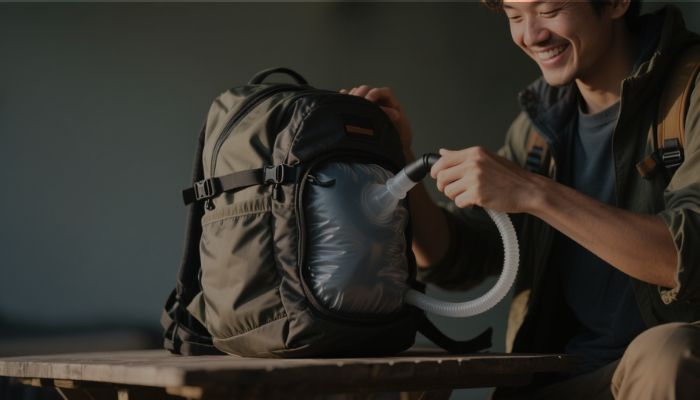Introduction
When you’re heading out on a trip, space is everything. Whether it’s a weekend getaway, a month-long backpacking adventure, or a business trip, maximizing your luggage space without sacrificing essentials is crucial. That’s where the vacuum compression backpack comes in.
In this detailed guide, you’ll learn exactly how to use a vacuum compression backpack effectively, using practical steps, real-world tips, and smart travel strategies. By the end, you’ll know how to pack smarter, travel lighter, and avoid common mistakes.
What Is a Vacuum Compression Backpack?
A vacuum compression backpack is a hybrid travel solution combining storage with air-compression technology. These backpacks feature built-in compression systems—manual valves, roll-top closures, or pump-assisted compartments—that reduce the volume of your packed items by expelling trapped air. This means you can pack more, carry less, and stay organized.
Why Learn How to Use a Vacuum Compression Backpack Effectively?
Using the backpack without knowing how to compress items correctly can lead to wasted space, wrinkled clothing, or broken zippers. Effective usage maximizes the space, protects your belongings, and prolongs the backpack’s life.
Step-by-Step Guide: How to Use a Vacuum Compression Backpack Effectively
Choose the Right Items to Compress
Not all items are suited for vacuum compression. Focus on compressible, soft materials:
-
T-shirts, sweaters, pants
-
Towels and sleepwear
-
Underwear and socks
Avoid compressing:
-
Fragile items (e.g., electronics, cosmetics)
-
Food or perishables
-
Documents or books
Pro tip: Roll your clothes instead of folding them. It prevents wrinkles and optimizes space.
Use Built-In Compression Compartments Wisely
Most modern vacuum compression backpacks come with designated compartments for compressible items. These usually have:
-
Roll-top designs
-
Air valves
-
Dual zippers for forced air compression
Load your soft items into these compartments first. Ensure they’re evenly distributed to maintain backpack balance.
Seal and Compress Correctly
Once your compressible items are loaded:
-
Close the zippered or roll-top section securely.
-
If using a valve, open it and press down on the contents to release air.
-
Roll or push from the top downward, expelling as much air as possible.
-
Seal the valve or secure the roll to lock in compression.
Important: Don’t force the compression too much—it can damage zippers or seams.
Place Non-Compressible Items Strategically
After compressing clothes, layer the rest of your items:
-
Top Layer: Essentials like snacks, chargers, books
-
Side Compartments: Water bottles, umbrellas
-
Bottom Layer: Shoes, travel pouches
This layout ensures better weight distribution and easy access during security checks.
Balance Your Load for Comfort
A fully compressed pack can feel dense. Make sure to:
-
Place heavier items near the center of your back
-
Use padded shoulder straps and chest clips
-
Adjust waist belts to distribute weight evenly
Overstuffing can lead to discomfort, especially during long walks. Keep your back and shoulders happy.
Check Airline Carry-On Requirements
Vacuum compression allows you to reduce size significantly—but don’t go overboard. Some airlines limit weight even if the bag fits under the seat.
Use a digital luggage scale and keep an eye on the dimensions. Better safe than facing overweight fees at the gate!
Unpack Thoughtfully
When you arrive:
-
Open the compression compartments gently
-
Allow clothes to breathe
-
Hang garments to eliminate wrinkles
Some fabrics might need a quick steam or iron after compression—especially dress shirts or formalwear.
Common Mistakes to Avoid
Overstuffing Beyond Capacity
Compression is not magic. Overpacking can strain zippers, deform the bag, or tear the internal lining. Respect the backpack’s limits.
Ignoring Maintenance and Cleaning
Post-trip, clean the bag according to manufacturer guidelines. Wipe down the valve, remove dust, and hang it to air out.
Compressing for Too Long
Long-term compression can leave permanent wrinkles and musty smells. Unpack promptly after each trip.
Bonus Tips to Maximize Efficiency
-
Use compression cubes for categorizing items even within the compression layer
-
Layer by frequency of use: least-used items at the bottom, daily-use at the top
-
Label compartments if your backpack has multiple access points
These tips not only keep you organized but save time during your travels.
Best Use Cases for a Vacuum Compression Backpack
Short Business Trips
Perfect for fitting suits, shirts, and shoes in a single backpack—without creases or clutter.
Backpacking Europe or Asia
Pack light but bring all essentials. Compress cold-weather gear for alpine stops and unzip easily for beachwear at coastal towns.
Weekend Escapes
Skip the rolling luggage. Pack all your essentials into a single, easy-to-carry backpack that fits under any airline seat.
FAQs
Can I use this type of backpack for international flights?
Absolutely. Just ensure it meets the airline’s size and weight rules.
Will compressing items ruin my clothes?
Not if done correctly. Roll items instead of folding them, and unpack them soon after arriving.
Is a hand pump better than a roll-type bag?
Depends on preference. Roll types are faster; pumps provide tighter compression.
How long does compression last?
Until reopened. Quality valves can hold compression for days or weeks.
Can I wash the backpack?
Most can be spot-cleaned or hand-washed. Always follow the care label.
Are there vacuum compression backpacks for women?
Yes. Many brands offer gender-specific fits for better comfort and weight distribution.
Conclusion
Learning how to use a vacuum compression backpack effectively is a smart move for any traveler. It allows you to travel lighter, stay more organized, and save money on baggage fees. With a little practice, packing becomes not only easier but also more efficient and enjoyable.
Whether you’re navigating airports, hiking through mountains, or attending business meetings—your vacuum compression backpack will become your go-to gear for all travel occasions.




